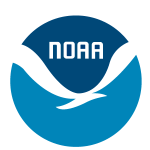- Industria: Government
- Number of terms: 30456
- Number of blossaries: 0
- Company Profile:
NOAA Coral Reef Conservation Program, National Oceanic and Atmospheric Administration, U.S. Department of Commerce
A new DNA sequence formed by the joining, usually in vitro, of two non-homologous (from different sources) DNA molecules, using recombinant DNA technologies.
Industry:Natural environment
A NOAA program that uses satellite and in situ monitoring stations to monitor high sea surface temperature events and to analyze conditions that may lead to coral bleaching.
Industry:Natural environment
A NOAA program whose mission is to provide services to help improve and sustain coral reef health throughout the world. Long term goals are: establish an international network of coral reef researchers for the purpose of sharing knowledge and information on coral health and monitoring; provide near real-time data products derived from satellite images and monitoring stations at coral reef areas; provide a data repository for historical data collected from coral reef areas; and add to the general fund of coral reef knowledge.
Industry:Natural environment
A NOAA program whose purposes are: (1) to preserve, sustain, and restore the condition of coral reef ecosystems; (2) to promote the wise management and sustainable use of coral reefs; (3) to develop sound scientific information on the condition of coral reef ecosystems and the threats to such ecosystems; (4) to assist in the preservation of coral reefs by supporting conservation programs, including projects that involve affected local communities and nongovernmental organizations; (5) to provide financial resources for those programs and projects; and (6) to establish a formal mechanism for collecting and allocating monetary donations from the private sector to be used for coral reef conservation projects.
Industry:Natural environment
A non-profit group or association organized outside of institutionalized political structures to obtain particular social objectives (such as environmental protection) or serve particular constituencies.
Industry:Natural environment
A partnership of U.S., Canadian, and Mexican agencies, other organizations, and taxonomic specialists cooperating on the development of an online, scientifically credible, list of biological names. ITIS is also a participating member of Species 2000, an international project indexing the world's known species.
Industry:Natural environment
A phenomenon characterized by unusually cold ocean temperatures in the eastern Equatorial Pacific, compared to El Niño, which is characterized by unusually warm ocean temperatures in the eastern Equatorial Pacific.
Industry:Natural environment
A phylum of elongated, often flattened marine worm-like animals comprising nearly 1000 species which range in size from less than an inch to nearly 30 m. They are carnivorous and feed upon annelid worms as well as other marine animals. Their most distinctive structure is a proboscis which is used for food capture, defense, and burrowing into the soft substrate. The sexes are separate in most species and fertilzation is external. Many are capable of reproducing asexually by fragmentation of the body. They are also called "ribbon worms".
Industry:Natural environment
A phylum of extremely simple and cryptic marine animals, for which only two species have been described, Trichoplax adhaerens and Treptoplax reptans. These tiny animals were discovered in Europe in the late 1800's living on the glass walls of an aquarium. Since then, most of what has been learned about their biology has come from studying cultures kept in various laboratories around the world. Their bodies are made up of only a few thousand cells of just four types. They also have the smallest amount of DNA measured for any type of animal. They lack tissues, organs and organ systems.They reproduce asexually, but it is not known if they can also reproduce sexually. Practically nothing is known about them in nature. Some scientists believe they emerged early in metazoan evolution, either before or just after the sponges (Porifera). However, recent DNA studies lead others to believe they emerged after the Cnidaria. Of the two species described, Treptoplax reptans has never been seen since its description in 1896, causing some to doubt its existence. However Trichoplax adhaerens has been reported from the Mediterranean and many tropical and subtropical locations around the world. It may be that Trichoplax adhaerens actually consists of more than a single species.
Industry:Natural environment
A phylum of marine invertebrates that superficially resemble bivalve mollusks because of their hinged bilaterally symmetrical shells.They are commonly known as "lampshells".
Industry:Natural environment
